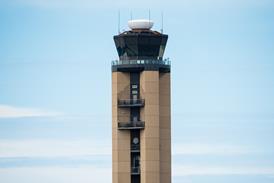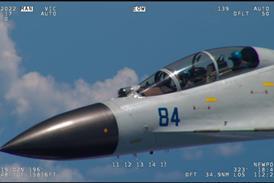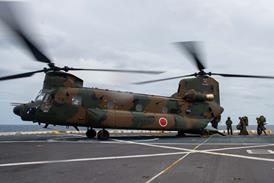Norwegian investigators have recommended that Airbus Helicopters redesign the main gearbox on the Super Puma family in order to improve its "robustness, reliability and safety" following the fatal 2016 crash of an H225.
In addition, the SHT safety body says there should be wide-reaching changes to the way that heavy rotorcraft are designed and certificated.
The final report into the accident, in which 13 passengers and crew were killed, concludes that a failure of a second-stage planet gear in the main gearbox epicyclic module was responsible for the loss of the main rotor at about 2,000ft.
That failure was caused by a fatigue fracture that "initiated from a surface micro-pit in the upper outer race of the bearing, propagating subsurface while producing a limited quantity of particles from spalling before turning towards the gear teeth and fracturing the rim of the gear without being detected", the final report into the 29 April 2016 accident says.
"The investigation has shown that the combination of material properties, surface treatment, design, operational loading environment and debris gave rise to a failure mode which was not previously anticipated or assessed."
In addition, it expressly rules out the actions of the crew or maintenance activities by the operator as potential causes.
However, SHT has been unable to determine a root cause for the initiation of the fatigue cracking. "The failure developed in a manner which was unlikely to be detected by the maintenance procedures and the monitoring systems fitted to LN-OJF at the time of the accident," it says.
Previously, subsurface cracking had been accompanied by spalling – or the break-up of a bearing surface – generating metallic particles that are in turn picked up by chip detectors, providing an early warning of a problem.
DESIGN RECOMMENDATION
In its sole recommendation aimed at the manufacturer, SHT recommends that "Airbus Helicopters revise the type design to improve the robustness, reliability and safety of the main gearbox in the AS332 L2 and EC225".
Airbus Helicopters is unlikely to undertake a wholesale redesign of the main gearbox for the Super Puma line, but will instead bring incremental changes to the component.
The company is already working with five operators to gather in-flight gearbox data from 17 in-service H225s. This will be married with data already gathered from component bench tests – including artificial crack propagation – in order to refine crack detection capability, which could be linked to a helicopter's health and usage monitoring system.
It had previously initiated a number of modifications to the gearbox as part of the safety barriers introduced to allow the H225 and AS332 L2 to return to service. These included the introduction of a full-flow magnetic plug to improve particle chip detection and the replacement of any second-stage planet gears equipped with bearings made by German specialist FAG.
Analyses conducted in the wake of the accident revealed that the FAG design had a greater probability of failure within the operational lifetime of the component.
Crucially, the FAG gear was also fitted to an AS332 L2 (G-REDL) which crashed in similar circumstances off the Scottish coast in 2009, killing all 16 on board.
SHT says safety measures introduced by Airbus Helicopters after the G-REDL accident "could have been more effective with regards to a possible scenario with limited spalling, assessing the effectiveness of the detection system and reviewing the MGB design features".
REGULATOR FAILINGS
In addition, EASA was equally at fault, it says: "In summary, Airbus Helicopters and EASA did not successfully manage to realise the safety potential from the G-REDL accident report."
Noting that the failure of a single component caused the catastrophic failure of the main gearbox and subsequent loss of the main rotor, SHT also recommends that EASA develop a main gearbox certification specification to prevent such a situation occurring on future designs.
EASA should also research methods for improving the detection of component degradation in helicopter epicyclic planet gear bearings, says the report.
The regulator should also carry out research into "crack development in high-loaded case-hardened bearings" and "review and improve the existing provisions and procedures applicable to critical parts on helicopters in order to ensure design assumptions are correct throughout its service life".
The H225 (LN-OJF) was being operated by CHC Helikopter Service on crew-change operations for Statoil. It was returning from the Gullfaks oil field to Bergen's Flesland airport when it came down on Norway's west coast, near Turøy.
It had been flying at 140kt (260km/h) and 2,000ft when the main rotor began to "tilt erratically" before detaching shortly after.
"Without its main rotor, the helicopter initially started to roll right near 360° while yawing to the right. It then slowly started to roll left while the helicopter nose ultimately pointed nearly vertically towards the ground," says the report, following a "ballistic curve".
In the wake of the crash, the civil fleets of both the H225 and AS332 were grounded. EASA initially lifted the flight restrictions in October 2016, with the safety authorities in the UK and Norway only moving to lift the ban in July last year.
However, no operator has yet attempted to return the type to service in the North Sea.
It is understood that Airbus Helicopters sees limited demand from the North Sea region, resulting from both reputational and wider market issues, but believes the H225 will see continued success in military and parapublic roles.
In addition, deals involving second-hand aircraft, such as a recent order from Ukraine that involved a significant number of former CHC helicopters, are thought to be imminent.
Airbus Helicopters expresses "deep regret" for the accident and offers its "sincere and profound sympathies to the families of the bereaved".
It notes that that neither the aviation authorities nor the industry had "ever seen the type of crack in the main gearbox that led to the LN-OJF accident".
"There are similarities with the 2009 G-REDL accident. However, without key evidence at the time, it was impossible to put in place measures which might have prevented the LN-OJF accident," it says.
EASA also defends its actions in the period after the G-REDL crash, noting that the investigation, conducted by the UK Air Accidents Investigation Branch "did not establish the root cause of the gear fatigue failure" because some parts were not recovered.
"The decisions taken by EASA after the G-REDL accident were based on the knowledge available at the time, and the actions put in place were justified and commonly agreed.
"The AIBN report now identifies micro-pitting as initiating the crack that, with limited spalling, led to the gear failure in the case of LN-OJF. This had not been identified with respect to the G-REDL accident investigation or analysis," says EASA.
Source: FlightGlobal.com


























